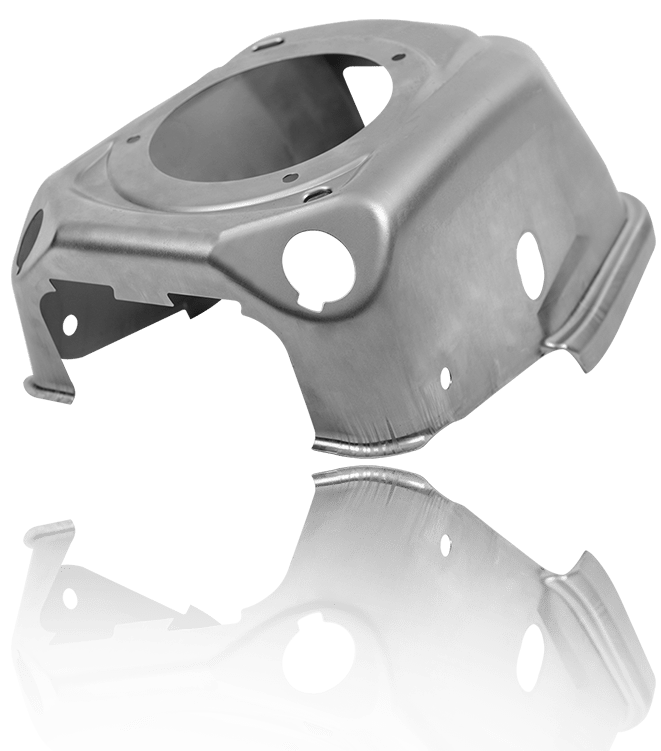Leading Metal Stamping Solutions for High-Quality and Cost-Effective Production
Leading Metal Stamping Solutions for High-Quality and Cost-Effective Production
Blog Article
Checking Out the World of Steel Stamping: From Style to Manufacturing
Within the world of manufacturing, steel marking attracts attention as a specific and efficient technique for shaping metal sheets right into various types with remarkable uniformity. From the first layout stage where elaborate patterns take shape to the complex production processes, steel marking is a blend of virtuosity and engineering. Looking into this world unveils a complex interaction of creativity and technological mastery, offering a glimpse right into a world where innovation meets workmanship.
History of Steel Stamping
Steel stamping, a widely used manufacturing procedure today, has an abundant history that goes back to ancient times (Metal Stamping). The beginnings of steel stamping can be mapped to ancient civilizations such as the Egyptians, who utilized marking methods to embellish precious jewelry and ornaments with complex layouts. Over time, steel stamping advanced, with civilizations like the Greeks and Romans using it for creating coins and attractive things

In the 20th century, metal marking continued to progress with the assimilation of automation and computer mathematical control (CNC) technology. These advancements further increased the efficiency and precision of steel marking procedures, making it a vital part of modern-day production throughout industries such as automotive, aerospace, and electronics. Today, steel marking continues to be an essential production procedure, incorporating practice with development to satisfy the demands of a regularly evolving industry.
Layout Factors To Consider and Prototyping
When developing metal marking jobs, thorough interest to make considerations and prototyping is essential for ensuring optimal manufacturing outcomes. Style considerations in metal stamping consist of product choice, component geometry, tooling layout, and production expediency. Selecting the ideal material is vital as it influences the part's efficiency, price, and manufacturability. Component geometry affects the complexity of the stamping procedure and the capability of the last product. Tooling style plays a considerable function in the success of metal marking projects, influencing component accuracy, tool long life, and production efficiency.
Prototyping is a vital stage in the steel marking process that allows designers to examine the layout, verify manufacturability, and make required adjustments prior to major manufacturing. By carefully taking into consideration style facets and utilizing prototyping, suppliers can improve the metal stamping procedure and attain high-grade, economical production end results.
Tooling and Equipment Essentials
Thinking about the essential duty that tooling layout plays in the success of metal stamping jobs, comprehending the vital tools and tools called for is critical for achieving efficient production results. Tooling is an essential facet of steel marking, as it straight impacts the high quality and uniformity of the end products. Necessary view website tools include passes away, strikes, and components, which are custom-designed to shape and develop the steel into the desired parts. Dies are the main device utilized to reduce and create the metal, while punches aid create holes or details forms. Components hold the metal in location throughout the marking process, ensuring accuracy and repeatability. Furthermore, tools such as stamping presses, feeders, and coil handling systems are vital for automating the marking procedure and increasing performance. Purchasing high-quality tooling and equipment not just enhances manufacturing efficiency yet also results in greater precision, reduced waste, and total price savings in steel stamping procedures.
Manufacturing Refine and Quality Assurance
Efficiently managing the manufacturing procedure and applying durable top quality control measures are vital for making sure the success of steel stamping jobs. The production procedure in steel marking entails a collection of actions that must be meticulously coordinated to accomplish optimum results.
Quality control in steel marking is extremely important to supply products that satisfy the required specifications. Evaluating the stamped parts at various phases of manufacturing helps recognize any kind of flaws beforehand, protecting against expensive rework or scrap. Methods such as dimensional inspection, visual evaluation, and material testing are typically employed to make certain the top quality of the stamped parts. By preserving rigorous quality control criteria, manufacturers can maintain their online reputation for providing premium steel stamped products.
Applications and Sector Insights
In the world of metal stamping, the effective application of manufacturing procedures and look here high quality control measures directly influences the efficiency and dependability of different market applications and gives beneficial insights into the sector's operational dynamics. Steel stamping discovers extensive application throughout diverse industries, consisting of auto, aerospace, electronics, and home appliances. In the automobile field, metal marking plays a crucial role in generating elements such as chassis, brackets, and architectural components with high accuracy and performance. The aerospace market relies upon steel marking for producing intricate components like panels, braces, and fittings that meet rigorous quality criteria (Metal Stamping). In the electronic devices industry, steel stamping is made use of to develop precise components like ports, terminals, and warmth sinks. In addition, metal marking promotes the production of numerous home devices, consisting of refrigerators, cleaning machines, and ovens, by providing economical options for producing long lasting and complicated parts. Recognizing the applications and industry understandings of steel stamping is essential for enhancing production procedures and improving product high quality throughout different markets.

Verdict
Layout considerations, prototyping, tooling, devices, production site link procedures, and top quality control are vital facets of metal marking. With its extensive applications and sector understandings, metal marking continues to be a functional and reliable production process.
Report this page